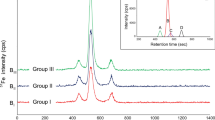Abstract
The purpose of the study was to investigate the effect of subchronic aluminum (Al) exposure on iron (Fe) homeostasis in rats. One hundred Wistar rats were divided into two groups. Experimental rats were given drinking water containing aluminum chloride (AlCl3, 430 mg Al3+·L−1), while control rats were given distilled water for up to 150 days. Ten rats were sacrificed in each group every 30 days. Mean corpuscular hemoglobin (MCH), and serum levels of Al, Fe, transferrin (TF), total iron binding capacity (TIBC), and soluble transferrin receptor (sTfR) were measured. Al-treated rats showed significantly decreased bodyweight and increased Al and Al/Fe levels during the experimental period. Fe levels and MCH were higher on day 150 in the experimental group than in the control group. TF content and TIBC were higher, whereas erythrocyte counts and sTfR content were lower in the experimental group than in the control group from days 90 and 60, respectively. Longer duration of Al administration increased the serum levels of Al, TF, Al/Fe, and TIBC and decreased sTfR. MCH and Fe levels decreased first, and then increased. The results indicate that chronic exposure to Al disturbed Fe homeostasis.
Similar content being viewed by others
References
Rengel Z (2004) Aluminium cycling in the soil-plant-animal-human continuum. Biometals 17:669–689
Ganchev T, Dyankov E, Zacharieva R (1998) Influence of aluminium on erythropoiesis, iron metabolism and some functional characteristics of erythrocytes in rats. Acta Physiol Pharmacol Bulg 23:27–31
Farina M, Rotta LN, Soares FAA et al (2005) Hematological changes in rats chronically exposed to oral aluminum. Toxicology 209:29–37
Garbossa G, Gutnisky A, Nesse A (1996) Depressed erythroid progenitor cell activity in aluminum-overloaded mice. Miner Electrolyte Metab 22:214–218
Brody T (1994) Inorganic nutrients. Nutritional Biochemistry 6:527–544
Mahieu S, del Carmen Contini M, Gonzalez M et al (2000) Aluminum toxicity. Hematological effects. Toxicol Lett 111:235–242
Farina M, Rotta LN, Soares FA (2005) Hematological changes in rats chronically exposed to oral aluminum. Toxicology 209:29–37
Andrews NC, Schmidt PJ (2007) Iron homeostasis. Annu Rev Physiol 69:69–85
Bohrer D, Dessuy MB, Kaizer R et al (2008) Tissue digestion for aluminum determination in experimental animal studies. Anal Biochem 377:120–127
Van Wyck DB, Schlifman RB, Stivelman JC et al (1988) Rapid sample preparation for determination of iron in tissue by closed-vessel digestion and microwave energy. Clin Chem 34:1128–1130
Olson AD, Hamlin WB (1969) A new method for serum iron and total iron-binding capacity by atomic absorption spectrophotometry. Clin Chem 15:438–444
Yokel RA, Hicksc CL, Rebecca L (2008) Florencea aluminum bioavailability from basic sodium aluminum phosphate, an approved food additive emulsifying agent, incorporated in cheese. Food Chem Toxicol 46:2261–2266
O'Neil-Cutting MA, Crosby WH (1986) The effect of antacids on the absorption of simultaneously ingested iron. JAMA 255:1468–1470
Tielemans C, Kalima L, Collart F et al (1985) Red blood cells indices and aluminium toxicity in haemodialysis patients. Proc Eur Dial Transpl Assoc Eur Ren Assoc 21:395–398
Losekann A, Ureña P, Khiraoui F et al (1990) Aluminium intoxication in the rat induces partial resistance to the effect of recombinant human erythropoietin. Nephrol Dial Transplant 5:258–263
Chmielnicka J, Nasiadek M, Lewandowska-Zyndul E et al (1996) Effect of aluminum on hematopoiesis after intraperitoneal exposure in rats. Ecotoxicol Environ Saf 33:201–206
Röllin HB, Theodorou P, Kilroe-Smith TA (1991) The effect of exposure to aluminium on concentrations of essential metals in serum of foundry workers. Br J Ind Med 48:243–246
Morgan EH, Redgrave TG (1998) Effect of dietary supplementation with aluminum and citrate on iron metabolism in the rat. Biol Trace Elem Res 65:117–131
Fairweather-Tait SJ (1982) The effect of different levels of wheat bran on iron absorption in rats from bread containing similar amounts of phytate. Br J Nutr 47:243–249
Sharpe LM, Peacock WC, Cooke R et al (1950) The effect of phytate and other food factors on iron absorption. Nutr 41:433–446
Donovan A, Roy CN, Andrews NC (2006) The ins and outs of iron homeostasis. Physiology 21:115–123
Cannata JB, Gómez AC, Fernández MMJ et al (1991) Iron uptake in aluminium overload: in vivo and in vitro studies. Nephrol Dial Transplant 6:637–642
Han J, Dunn MA (2000) Effect of dietary aluminum on tissue nonheme iron and ferritin levels in the chick. Toxicology 142:97–109
Aggarwal P, Handa R, Wig N et al (1999) Intravascular hemolysis in aluminium phosphide poisoning. Am J Emerg Med 17:488–489
Fatemi SJA, Kadir FHA, Moore GR (1991) Aluminium transport in blood serum: binding of aluminum by human transferrin in the presence of human albumin and citrate. Biochem J 280:527–532
Kohgo Y, Niitsu Y, Kondo H et al (1987) Serum transferrin receptors as a new index of erythropoiesis. Blood 70:1955–1958
Beguin Y (2003) Soluble transferrin receptor for the evaluation of erythropoiesis and iron status. Clin Chim Acta 329:9–22
McGregor SJ, Naves ML, Oria R et al (1990) Effects of aluminium on iron uptake and transferrin-receptor expression by human erythroleukaemia K562 cells. Biochem J 272:377–382
Yamanaka K, Minato N, Iwai K (1999) Stabilization of iron regulatory protein 2, IRP2, by aluminum. FEBS Lett 462:216–220
Acknowledgments
This project was supported financially by the Natural Science Foundation and the Department of Education of Heilongjiang Province (Grant No. C200935/C120209 and 11521019, respectively) in China.
Author information
Authors and Affiliations
Corresponding author
Rights and permissions
About this article
Cite this article
Zhang, L., Li, X., Gu, Q. et al. Effects of Subchronic Aluminum Exposure on Serum Concentrations of Iron and Iron-Associated Proteins in Rats. Biol Trace Elem Res 141, 246–253 (2011). https://doi.org/10.1007/s12011-010-8725-y
Received:
Accepted:
Published:
Issue Date:
DOI: https://doi.org/10.1007/s12011-010-8725-y




